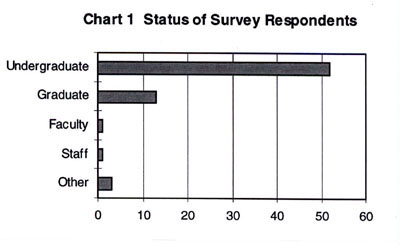
Wenxian Zhang
Head, Public Services
Olin Library
Rollins College
1000 Holt Ave. - 2744
Winter Park, FL 32792
U.S.A.
Wzhang@Rollins.edu
ABSTRACT. A random survey was conducted to assess users' preferences comparing the Internet web access with library CD-ROM databases in a liberal arts college library. UMI's Periodical Abstracts with full-image on CD-ROM is the database of choice for student users at the Olin Library. As electronic databases become increasingly available, library professionals should carefully review users' information needs, focus on database contents, and select the cost-effective products that best support the educational missions of their institutions.
Since its dedication in 1985, the Olin Library has been serving as the intellectual learning center of Rollins College, an independent and comprehensive liberal arts college located in Winter Park, Florida, with a total enrollment of 2,472 students. For the past decade, the Olin Library has fulfilled its role as the treasure house of books and printed materials and will continue to do so for many years to come; however, it is increasingly becoming the electronic learning and information research center of the college.
It is an indisputable fact that the computer information revolution has fundamentally changed library services across the nation for the past two decades. Two recent advancements of information technologies, in particular, have had significant impact on Olin Library public services. First, the introduction of CD-ROM technology has provided library users powerful access to large databases. Second, the creation of electronic networks has made online remote information access a reality. In 1994, Olin Library introduced UMI's ProQuest Periodical Abstracts with full-image on CD to the Rollins campus. It became an instant hit, especially among undergraduates of the college. In 1996, through a Mellon Foundation grant from the Associated Colleges of the South (ACS), Olin also gained Internet access to 11 OCLC FirstSearch databases including UMI's Periodical Abstracts and ABI/INFORM with ASCII full-text online. Since both systems are available in library side by side to all Rollins students, faculty and staff, this creates a unique opportunity for comparative study of online vs. CD-ROM databases in a small liberal arts college setting.
As information is increasingly recorded in digital format and electronic databases are continually becoming more complex, information storage and retrieval processes have profoundly changed. Over the past two decades three major migrations have occurred in library academic services: from printed resources to online electronic databases; from online databases to bibliographic and full-text CD-ROM databases; and from CD-ROM databases to online Internet access to bibliographic and full-text/full-image databases. Various studies have been conducted on the impact of electronic databases on library printed resources as well as CD-ROM technology on online databases.
Based on statistics at Texas A&M University, Vicki Anders, head of the library's automated information retrieval service, observed that "usage of the online equivalents of the databases began to decline only two or three months after the CD-ROM versions became available."1 She noticed that, while faculty and staff preferred mediated online searches, undergraduate students overwhelmingly favored CD-ROM. In another article she also pointed out that adding CD-ROM databases to their mediated and end-user searching programs had introduced far more users to the concept of computerized literature searching than could be accommodated by their online programs, and CD-ROM systems had provided a good teaching/learning opportunity for computerized literature searches since users were working in a less threatening environment.2
With the introduction of CD-ROM databases in academic libraries across the country, similar declines in mediated and end user online searches were also reported at Cornell, Carnegie Mellon, Vanderbilt, Kent and Oregon State University.3 In a 1991 article, Library Journal columnist Carol Tenopir reviewed the overall impact of CD-ROMs on online databases.4 She pointed out that, while mediated online searching took up librarians' time and was often limited to those who could afford to pay, CD-ROM searching returned the research function to the students and faculty, was highly visible, and usually was provided at no charge to users.
A literature review revealed that most research in this field focused only on the impact of CD-ROM databases on their online equivalents in academic libraries. Little study has been done on the impact of the online Internet access to electronic databases on their CD-ROM counterparts, this is probably because the Internet, especially the World-Wide-Web (WWW) access to large electronic databases, was not generally available until recent years.
The fact that both CD-ROM and Internet Web access to the UMI's Periodical Abstracts are available in the Olin Library presents an opportunity to examine the impact of Internet access to electronic databases on CD-ROM products. What will be library users' preferences given the option of Web vs. CD-ROM? Will Internet access replace CD-ROM databases, or can different media coexist? What will be the economic impact on library academic services? The objective of this paper is to address these issues currently faced by library and information service professionals from a liberal arts college's perspective.
ProQuest CD-ROM in Olin
Under the trade name "ProQuest", UMI began publishing its databases in CD-
ROM format in 1987.5 In the summer of 1994, Olin Library
signed a three-year
contract with UMI to purchase its ProQuest General Periodical Ondisc - Research
II edition for $12,765 each year. The complete package included the Full-image
General Periodicals at $4,775 per year, Periodical Abstracts Research II at
$2,750 per year, lease/purchase of a 4000I Workstation at $5,000 per year, and a
disk cabinet at $240 each year. At the end of the three-year term, the library
will have the option to keep the system hardware and renew only database and
software for $7,525 each year.
The General Periodicals Ondisc includes about 500 full-image titles covering the period from 1986 to current (coverage varies in individual titles); the Periodicals Abstracts Research II provides index and abstract access to 1800 plus periodical titles of various subjects since 1986; the 4000I workstation system includes a stand-alone 486SX personal computer with 33 Mhz speed, 4 MB RAM, 80 MB hard disk space, MS-DOS and pre-loaded search and retrieval software, standard keyboard and 19" ultra high resolution monochrome monitor. Other equipment includes one single-disc CD-ROM drive, a six-disc Pioneer changer and a Canon high-volume laser printer as well as a HP deskJet printer for citations. The library also had four 286 computers on its Novell network for index and abstract retrieval. When FirstSearch online access was added in late 1996, index workstations were reduced to two.
UMI's ProQuest CD-ROM database is designed to be used by both end users and information professionals. As one librarian stated: "the biggest advantage of the ProQuest user interface over many others I have used is that there is just one user interface for all skill levels."6 Over the years the system has proven to be an excellent tool for teaching and learning computer research strategies in the Olin Library. One can access the database using very simple as well as sophisticated search strategies that employ Boolean logic and proximity operators. Beginning users can try different search techniques, analyze their results and modify their methods until they have the confidence to handle the most complex searches. Besides keyword search, the browsing option allows users to scan the list of indexed terms in the database and put them directly into a new search. Customized library holding information also adds additional value and convenience to system users.
The journal coverage in ProQuest Periodical Abstracts is fairly broad to support an undergraduate curriculum. The database is updated monthly, and journal articles are usually available one or two months after their publication. the full-image database contains scanned images of articles including graphics as they appeared in their original print publications. Though they may not be as current as one would like, the image disks provide the same communication value found in the original format plus improved security, easy handling and storage over printed copies. The only problem in this area is changes in journal coverage, especially withdrawal of titles from the database. Even though it has not happened on a large scale nor on a regular basis, it already has negative impact on library services, particularly in the case of two journals: Science and Nature.
FirstSearch Online Access at Rollins
Soon after FirstSearch was introduced by OCLC in October 1991, libraries
nationwide were drawn to the service for its ease of use and reasonable cost per
search. In January 1996, OCLC launched the FirstSearch web access.7 In the
fall of 1996, through a $1.2 million Mellon Foundation grant from the Associated
Colleges of the South (ACS), Olin Library gained Internet web access to nine
OCLC FirstSearch basic databases plus UMI's Periodical Abstracts and ABI/INFORM
with ASCII full-text online.
Under the terms of the three-year contract with OCLC and UMI, all ACS member libraries have a combined twenty simultaneous-user access to the OCLC basic package of nine databases, 15-user access to the UMI's Periodical Abstracts and 5-user access to ABI/INFORM. The project costs are prorated based on the enrollment of 13 participating institutions of the ACS. A total of $350,000 of Mellon grant is allocated to OCLC/UMI database costs for the three-year period, including $184,295 (100% of the database cost) for the first year, $120,705 (63%) and $45,000 (23%) for the second and third year respectively. The total budgeted OCLC/UMI database cost for Rollins College during the three-year term is $46,374, including $17,559 (100% paid by the Mellon grant) for the first year, $13,112 (57% of grant at $7,535, 43% of library budget at $5,577) and $15,703 (23% of grant at $3,555, 77% of library budget at $12,148) for the second and third year respectively. Therefore, the real database cost for the Olin Library will be $17,725 incurred during the second and third year of the project. Under the terms of the grant, Olin also purchased 3 Pentium 100 Mhz computers at $1,500 each, an Ariel workstation with a HP 4C Scanjet and a HP 5P laser printer.
FirstSearch expands electronic database access beyond library walls and local area networks. As long as users have Internet Web access, they can conduct information searches from dorms, offices, computer labs, or at home via the library homepage. With this flexibility, FirstSearch moves academic librarians one step closer to achieving the mission of the profession, which is to provide seamless access to bibliographic, abstracting, and full-text information when and where users need it. Point-and-click access makes information searching an easy and simple process. Users can modify their searches, tag, print, download or e-mail search results; they can also view local library holdings information, request electronic Interlibrary Loans (ILL), or order articles from document suppliers in FirstSearch.
There is one catch to the FirstSearch web access: reliability has been an issue for database users at the Olin Library. This is mainly a result of some technical difficulties of early-stage Internet technology such as traffic jams and low capacity of networks, etc.
Economic Impacts on Olin Library Services
Since Olin has had ProQuest CD-ROM for almost three years, its impact on
certain areas of library services is obvious. First, a substantial decline in
the use of online mediated Dialog searches was noticed over years. For example,
in 1996-97 academic year, library expenses for online searches decreased by 26%
from the previous year. Secondly, full-image journal titles on CD greatly
expanded the library's periodical coverage. Meantime, a total of seventy-six
print journal subscriptions were canceled realizing a yearly saving of $4,653.
Some backfile binding and microfilm were also canceled because of duplicated
coverage on full-image CDs.
As to ProQuest CD-ROM periodical database versus FirstSearch online access in Olin Library, it is difficult to determine a direct cost comparison because of the involvement of the consortium and the foundation grant. Though it seems that FirstSearch is a little more expensive in terms of annual costs for Olin, it in fact provides users online access to a much larger database group than the ProQuest CD-ROM. It is clear that without the Mellon Foundation grant and the ACS group discount, it would be very difficult for Rollins to have online web access to electronic databases under financially favorable terms, not to mention supporting both CD-ROM and online databases at the same time.
At the end of the third year when the Mellon grant is depleted, all ACS members will have to decide how to proceed with the project. Since nearly all institutions of higher education are currently experiencing some degree of financial crisis, it is unlikely for a liberal arts college such as Rollins to support both CD-ROM and Internet Web access to the electronic databases. It has become crystal clear that libraries will not be able to provide a full array of formats for all resources to their users. Furthermore, as the information costs shift from one medium to another, it will be unrealistic to assume that there are going to be substantial cost savings down the road. On the contrary, information costs will probably be increased over the coming years, but library users will gain access to much improved information services.
To analyze the use of online and CD-ROM databases from the students' perspective, a random user survey was conducted in April, 1997 in Olin Library. One-page survey forms with 9 questions (see Appendix) were distributed to users after their use of ProQuest CD and/or FirstSearch online databases. A total of 102 questionnaires was distributed during the survey month and 71 were returned with valid answers, thus the response rate is 70%. Seventy-four percent of the survey respondents were undergraduate students of the college, and 19% were graduate students. Faculty, staff and other users represented only 7% of the survey respondents (see Chart 1).

Database Contents
Eighty-six percent of users "agree" or "strongly agree" that ProQuest CD was
sufficient to their information needs, compared to only 64% with FirstSearch
online (Chart 2). This finding is interesting since FirstSearch is a group of
databases which contains much more information than ProQuest, even though UMI's
Periodical Abstracts on FirstSearch is very similar to ProQuest Research II on
CD. Since FirstSearch has only been available for several months compared to
more than two years for ProQuest in the Olin Library, it is possible that
benefits and potentials of FirstSearch online have not been fully realized by
the Rollins academic community. Furthermore, since the vast majority of the
survey respondents are undergraduate students of the college - as one student
stated: "I find everything I want in ProQuest" - to them a general electronic
periodical database is all they need for their schoolwork. It is observable
that ProQuest Periodical Abstracts is an excellent database for undergraduate
liberal arts studies. However, students will have to be cautioned that this is
only the starting point, rather than the ultimate answer to their information
search. Any serious researchers have to go beyond general periodical indexes
and into subject databases and other library resources in order to be
successful.
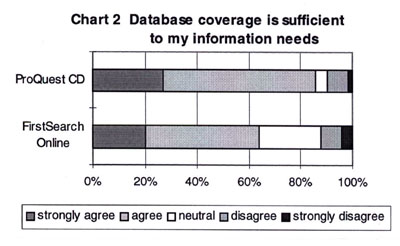
FirstSearch outscored ProQuest in the currency of its databases. Eighty- seven percent of FirstSearch users stated that they could find up-to-date information versus 74% for ProQuest (Chart 3). This finding is not surprising since many of FirstSearch databases are updated daily or weekly compared to the monthly schedule for the ProQuest database. Sometimes users have to wait for two months to access full-image articles on CD.
Database Reliability
As suspected, the real discrepancy between the two is database reliability.
Overwhelmingly 89% of users "strongly agree" or "agree" that ProQuest was very
reliable to use in Olin Library, compared to only 65% of FirstSearch users
(Chart 4). If the content of a database is the king, then system reliability
will make or break his kingdom. In the Olin Library the ProQuest CD is running
on a local Novell network and supported by the library computer coordinator.
Rarity of down time certainly contributed a great deal to the staggering
popularity of ProQuest on campus.
It is a different story to access FirstSearch over the web in the library. The Rollins campus network has a standard T1 connection to the Internet. Initially, the library faculty was very impressed by the potential of FirstSearch, however enthusiasm soon turned into reservation. Ever since the early beginning the Olin Library had difficulty accessing the web version of FirstSearch. Problems ranged from Internet traffic jams to limited simultaneous log-ons, as well as all kinds of system errors. Students became very frustrated when they could not connect to FirstSearch, or waited forever for a search result, and then saw their sessions were cut off in the middle of searches. They simply switched to ProQuest CD after several failed efforts on FirstSearch. Contacting OCLC for technical assistance had little impact on the effectiveness of the online service, as one OCLC technician stated: "More than 90% of Internet connections are beyond our control!"
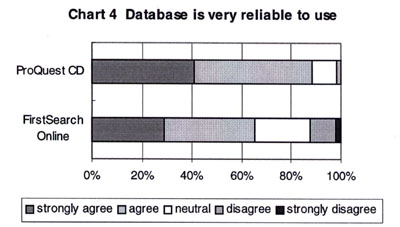
In terms of user friendliness, ProQuest CD also received favorite ratings from the library survey respondents (Chart 5). The majority of students felt it was easier to use and navigate than FirstSearch online. This finding is easy to validate, understanding the system reliability issue discussed above.
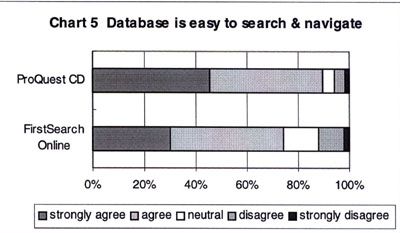
Overall Rating of the Databases
Based on their own experience, 86% of survey respondents rated the ProQuest
CD as "excellent" or "good", while 68% of users did so for FirstSearch online
databases (Chart 6). Chart 7 showed the weighted average ratings of both
databases by the library users. ProQuest outscored FirstSearch in all
categories except the currency of information. Clearly Olin library users
preferred ProQuest CD for its overall journal coverage, strong reliability and
ease of searching. This by no means is to say that the ProQuest CD system is
perfect. It definitely has its own serious shortcomings and needs further
improvement. Nevertheless, it remains the top database choice for periodical
information for the majority of undergraduate students of Rollins College.
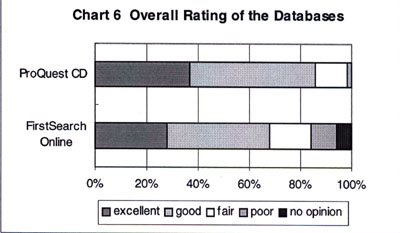
It is undeniable that FirstSearch is an excellent system with an outstanding group of databases. It has more potential than ProQuest CD running on a library local network. With the application of new client/server technology, it probably represents the future of electronic reference services. However, its advantage is also its weakness at this point. The problem lies in its information delivery system on the Internet, the World Wide Web. Unlike CD-ROM technology which has been widely used for more than a decade or so to become a mature medium, the Internet and web technology has only existed for the last few years. The new industry is currently experiencing the pain of tremendous growth. The information super highway is jammed because of its huge volume of traffic and the low carrying capacities of system computers.
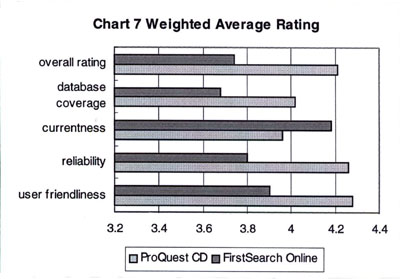
What good is a database if it is unreliable to library users? Poor reliability records are largely responsible for the low rating of FirstSearch online database system in Olin Library. Users clearly prefer the CD-ROM network for its reliability and local control, to the online system for currency and flexibility. In the battle of web versus CD-ROM, web apparently lost the first round here at Olin. But the war is not yet over. CD-ROM and Web technology will probably coexist in the library information services field and continue to complement one another for quite some time. With the new advancement of Internet technology and much improved tele-communication infrastructure in the future, Web databases or some other new technology could well replace all CD-ROM systems when accessibility and reliability are no longer concerns of information users.
Limitations of the Study
A notable limitation of the study is the relatively small size of the survey
sample. Related to this, the college faculty and staff were not well
represented in the study. Also, it would be desirable if the study were
conducted between the ProQuest CD and ProQuest Direct over the Internet instead
of UMI Periodical Abstracts on FirstSearch online, so a true-sense comparison of
web versus CD-ROM could be obtained.
The mission of library services in the age of computer and electronic technologies is to provide information at the point and the moment of users' needs. Unquestionably, content is still the key to the success of a library electronic database. The medium of information delivery systems has evolved over the years from printed indexes to magnetic tapes, disks and compact discs. So far, the new Internet World Wide Web technology holds the most potential to achieve the goal of library information services. However, it has not yet lived up to its promise because of various technical problems.
Even though the survey was conducted in a liberal arts college library with the above mentioned shortcomings, the study results still shed some light on the subject. Based on their own experience, the ProQuest CD-ROM database system is clearly preferred to the OCLC FirstSearch by the majority of library users surveyed at Rollins College. With local control and a strong reliability record, CD-ROM electronic databases certainly offer library users peace of mind. On the other hand the Internet web technology provides users up-to-date information and much needed flexibility, expanding database access beyond library walls and local area networks to offices, dorms and home. While CD-ROM databases require local expertise and regular technical maintenance, web access shifts the burden of database maintenance to its provider by giving up local control. Since each technology has its own advantages and disadvantages, CD-ROM databases are not likely to be immediately replaced by the Internet web access at this point. Instead, both of them will probably coexist peacefully to complement each other in the field of library information services for some years.
The economic impacts of these technological advancements on library information services are profound. As electronic index and abstract as well as full-text/image databases become increasingly available, library information costs are gradually shifting from print to digital resources, and from building up collection to providing access. However, it will be unrealistic to assume that there are some cost savings down the road. On the contrary, the information costs will probably be increased over the coming years, but library users will gain access to much improved information services.
Since nearly all higher education institutions across the nation are currently facing some fiscal obstacles, it is unlikely for most academic libraries to provide to their users a full array of formats for all resources. The challenge for today's library professionals is to carefully review the information needs of their users, and select cost-effective electronic products that best support the educational missions of their institutions.
1. Vicki Anders, "The Wiley Laser Disk Service at Evans Library,
Texas A&M
University," Public Access CD-ROMs in Libraries: Case Studies (Westport, Conn.:
Meckler, 1990) 191-197.
2. Vicki Anders and Kathy M.Jackson, "Online vs. CD-ROM: The
Impact of CD-ROM
Databases Upon a Large Online Searching Program," Online, (November 1988): 24-
32.
3. Linder Stewart and others, eds. Public Access CD-ROMs in
Libraries: Case
Studies (Westport, Conn.: Meckler, 1990).
4. Carol Tenopir, "The Impact of CD-ROM on Online," Library
Journal (February
1, 1991): 61-62.
5. Thomas Pack, "UMI - History in the Making," Library Hi Tech, 12:3 (1994):
91-100.
6. Mike McDermott, "UMI's ProQuest CD-ROM System: One
Librarian's Opinion,"
Online (January 1992) 82-84.
7. "FirstSearch Web: Point, Click and Find!" OCLC Reference
News (Winter
1996): 1.
Appendix
This survey is designed to evaluate the use of two electronic periodical databases - FirstSearch Online and ProQuest CD-ROM in the Olin Library. We would appreciate that you complete the questionnaire below along with any additional comments you feel would be helpful. (Unless otherwise noted, please check the single most appropriate response. Thank you.)
| 1. Rollins status: | |||||
|---|---|---|---|---|---|
| undergraduate | graduate | faculty | staff | other (specify) | |
| 2. Database coverage is sufficient to my information needs. | |||||
| strongly agree | agree | neutral | disagree | strongly disagree | |
| FirstSearch | |||||
| ProQuest CD | |||||
| 3. I usually can find up-to-date information in this database. | |||||
| strongly agree | agree | neutral | disagree | strongly disagree | |
| FirstSearch | |||||
| ProQuest CD | |||||
| 4. This database is very reliable to use in the library. | |||||
| strongly agree | agree | neutral | disagree | strongly disagree | |
| FirstSearch | |||||
| ProQuest CD | |||||
| 5. Searching & navigating in this database is fairly easy. | |||||
| strongly agree | agree | neutral | disagree | strongly disagree | |
| FirstSearch | |||||
| ProQuest CD | |||||
| 6. Screen layout and help menu in this database are clear, precise and easy to understand. | |||||
| strongly agree | agree | neutral | disagree | strongly disagree | |
| FirstSearch | |||||
| ProQuest CD | |||||
| 7. How would you rate this electronic database in general based on your own experience? | |||||
| excellent | good | fair | poor | no opinion | |
| FirstSearch | |||||
| ProQuest CD | |||||
| 8. I like this library electronic database best simply because: | |||||
| FirstSearch | |||||
| ProQuest CD | |||||
| 9. I see the most needed improvement to this database is: | |||||
| FirstSearch | |||||
| ProQuest CD | |||||
| PLEASE WRITE ANY ADDITIONAL COMMENTS ON THE BACK OF THE SURVEY, AND RETURN THIS FORM TO REFERENCE DESK. THANK YOU! | |||||